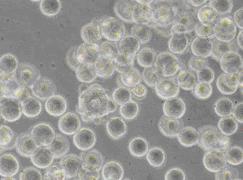The key difference between HEK293 and HEK293t is that HEK293 is an immortalized cell line derived from the embryonic human kidney that is transfected with sheared human adenovirus type 5DNA while HEK293t is a daughter cell line derived from HEK293 original cell line that is transfected with a plasmid vector carrying SV40 origin of replication.
Transfection is usually defined as the process of introducing foreign DNA and RNA into cells in order to influence their genotype and phenotype. Such introductions of foreign nucleic acids through various biological, chemical, and physical methods can change the properties of the cell. Ultimately, this allows the study of gene function and protein expression in the context of the cell. HEK293 and HEK293t are two cell lines that have been extensively used in cell biology research for many years because of their propensity for transfection.
CONTENTS
1. Overview and Key Difference
2. What is HEK293
3. What is HEK293t
4. Similarities – HEK293 and HEK293t
5. HEK293 vs HEK293t in Tabular Form
6. Summary – HEK293 vs HEK293t
What is HEK293?
HEK293 is an immortalized cell line derived from the embryonic human kidney that is transfected with sheared human adenovirus type 5DNA to produce many recombinant proteins. HEK293s were originally isolated from human kidney cells by Dutch biologist Alex Van der Eb in 1973. These cells were grown in tissue culture from a female fetus. Later, they were transfected with sheared human adenovirus type 5DNA by Frank Graham, a postdoctoral fellow in Van der Eb’s laboratory. This cell line was named HEK293 because it was Frank’s 293rd experiment.

Figure 01: HEK293
The incorporation of adenoviral genes into the HEK cell genome enables these cells to produce a high amount of recombinant proteins very efficiently. Moreover, the adenoviral vector contains the CMV promoter region; hence, it increases this efficiency further. This cell line has been used as a host for gene expression studies. This cell line is also used by the biotechnology industry to produce therapeutic proteins for gene therapy.
What is HEK293t?
HEK293t is a daughter cell line derived from the HEK293 original cell line that is transfected with a plasmid vector carrying SV40 origin of replication to produce a high amount of recombinant proteins. HEK293t is a human cell line that expresses a mutant version of the SV40 large T antigen. HEK293t was created in Michele Carlos’s laboratory at Stanford through the stable transfection of the HEK29E cell line with a plasmid encoding a temperature-sensitive mutant of the SV40 large T antigen. It was originally referred to as 293/tsA1609neo. This is because the transfection used to create a cell line that confers neomycin resistance and expression of the tsA 1609 allele of SV40 large T antigen.

Figure 02: HEK293t
Due to the expression of a mutant version of SV40 large T antigen, the transfected plasmids with SV 40 origin of replication can greatly increase the amount of recombinant protein. This cell line is commonly used in the biotechnological industry for protein expression and the production of recombinant retroviruses.
What are the Similarities BetweenHEK293 and HEK293t?
- HEK293 and HEK293t are two cell lines that have been extensively used in cell biology research because of their propensity for transfection.
- Both cell lines are laboratory-derived.
- These cell lines can greatly increase the amount of recombinant protein production.
- They are made through transfecting embryonic human kidney cells with a plasmid vector.
What is the Difference Between HEK293 and HEK293t?
HEK293 is an immortalized cell line derived from the embryonic human kidney that is transfected with sheared human adenovirus type 5DNA. In contrast, HEK293t is a daughter cell line derived from the HEK293 original cell line that is transfected with a plasmid vector carrying SV40 origin of replication. So, this is the key difference between HEK293 and HEK293t. Furthermore, HEK293 does not express the mutant version of the SV40 large T antigen. On the other hand, HEK293t expresses the mutant version of the SV40 large T antigen.
The following infographic lists the differences between HEK293 and HEK293t in tabular form for side by side comparison.
Summary – HEK293 vs HEK293t
HEK293 and HEK293t are two cell lines that have been extensively used in cell biology research because of their steady growth and propensity for transfection. HEK293 is an immortalized cell line derived from an embryonic human kidney that is transfected with sheared human adenovirus type 5DNA, while HEK293t is a daughter cell line derived from HEK293 original cell line that is transfected with a plasmid vector carrying SV40 origin of replication. Thus, this summarizes the difference between HEK293 and HEK293t.
Reference:
1. “Hek293: An Essential Human Cell Line with a Unexpected Origin.” Lab Pilot: The Laboratory Information Management Blog.
2. Bae, Dahae Hailey, et al. “Design and Testing of Vector-Producing hek293t Cells Bearing a Genomic Deletion of the sv40 t Antigen Coding Region.” Molecular Therapy. Methods & Clinical Development, American Society of Gene & Cell Therapy, 9 July 2020.
Image Courtesy:
1. “HEK293” By T. Demont (CC BY-SA 3.0) via Commons Wikimedia
2. “GFP in HEK293T” By jeremy Seto (CC BY-NC-SA 2.0) via Flickr
ncG1vNJzZmivp6x7pbXFn5yrnZ6YsqOx07CcnqZemLyue9ahmK1lmah6tbTEZpuinpaav6a6wp5km52krLKmuoyhnKRqaWh6orrDZp%2Beo2JugLV7